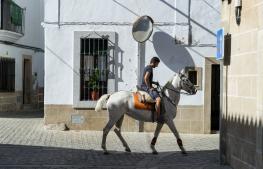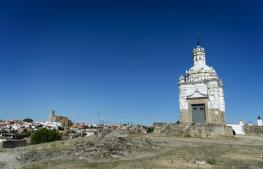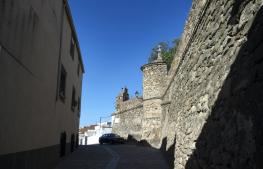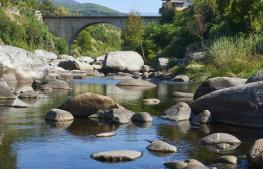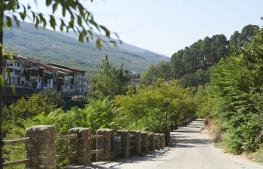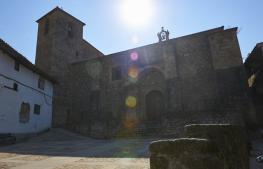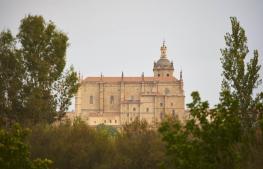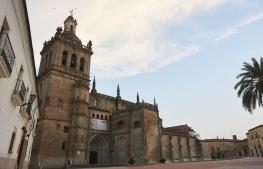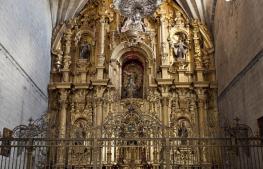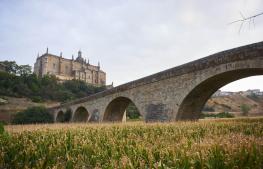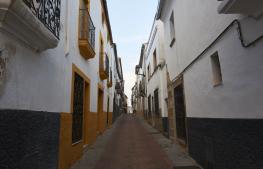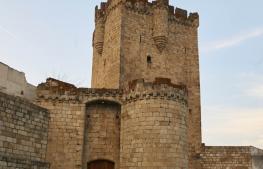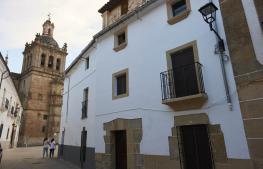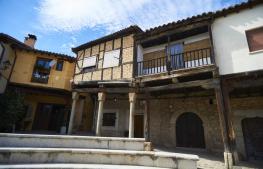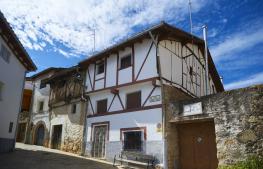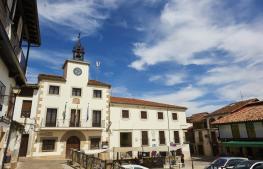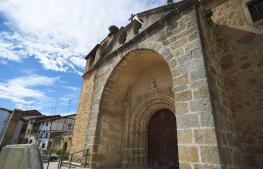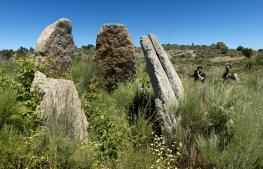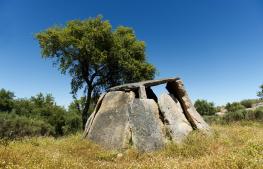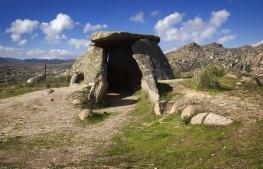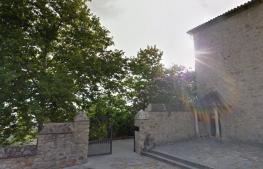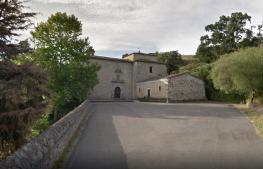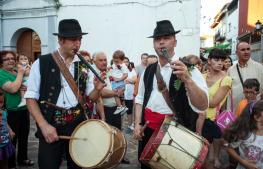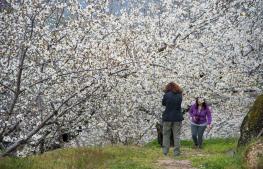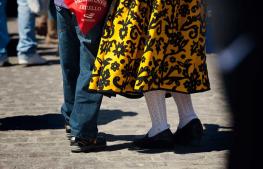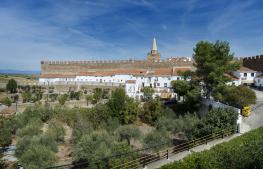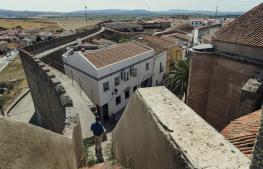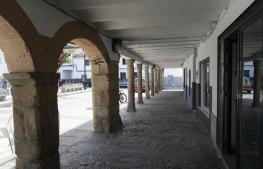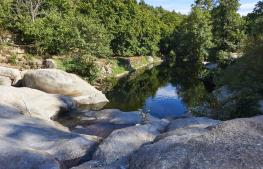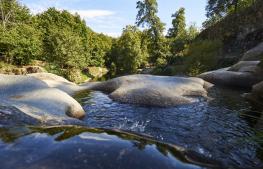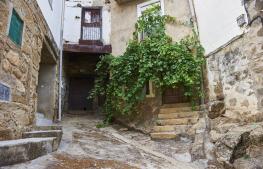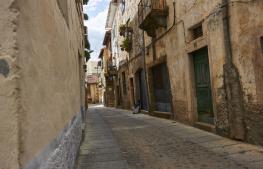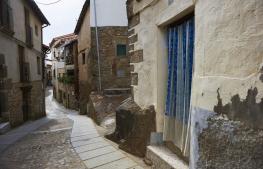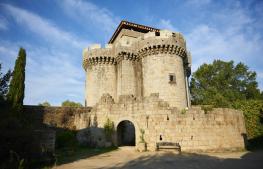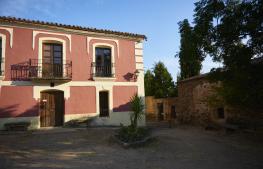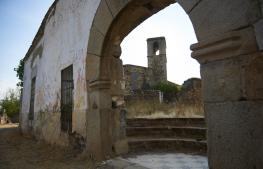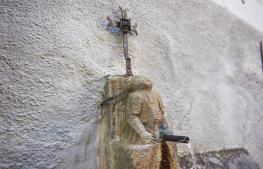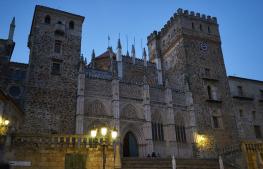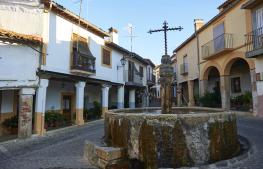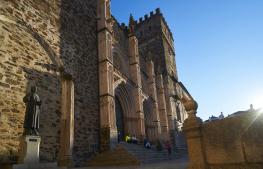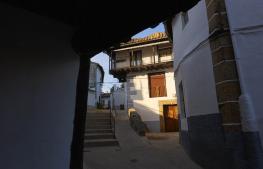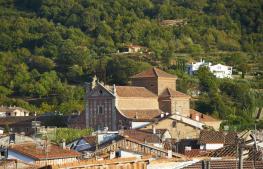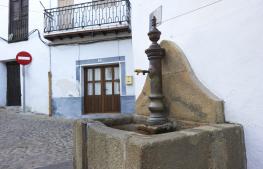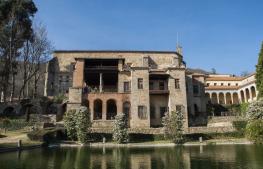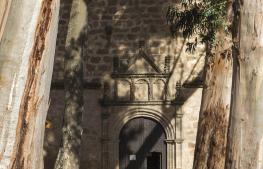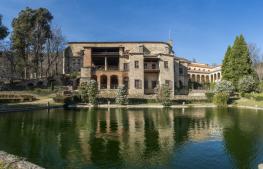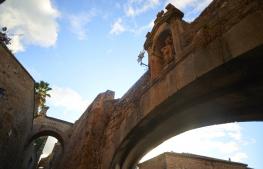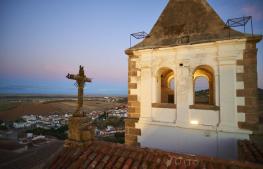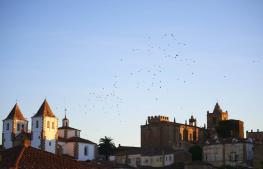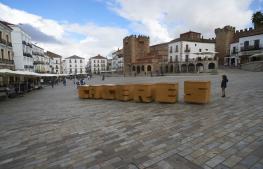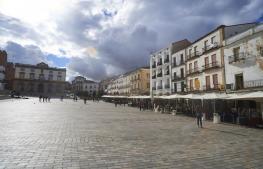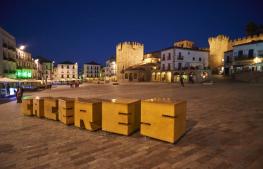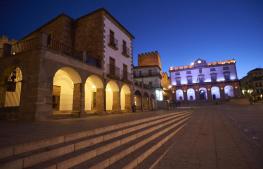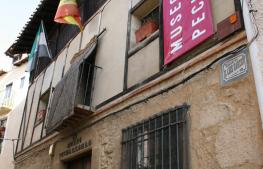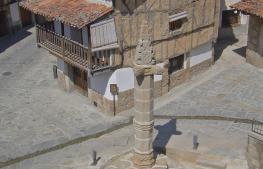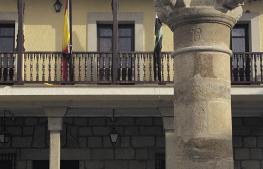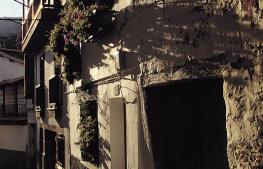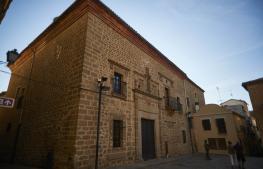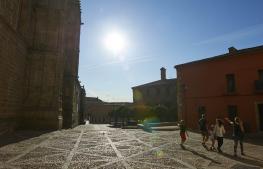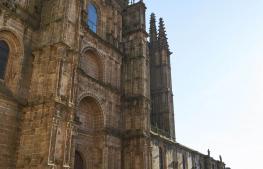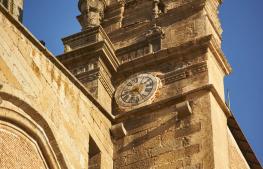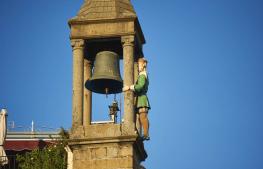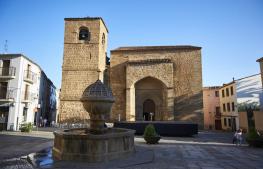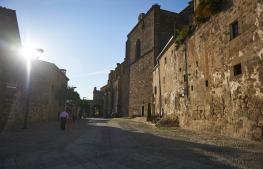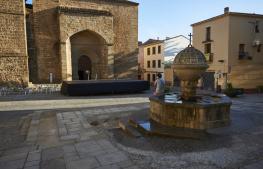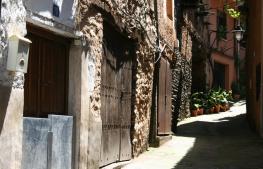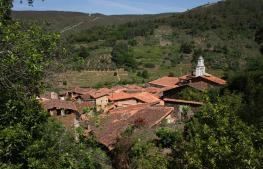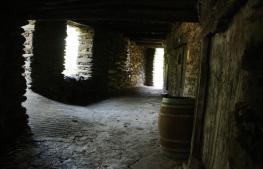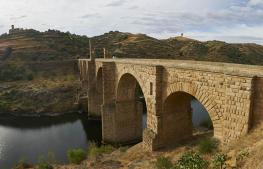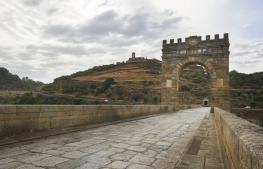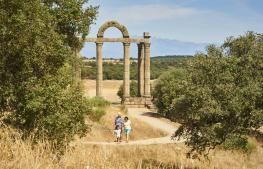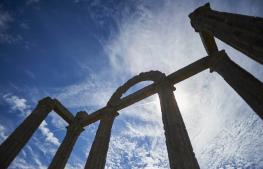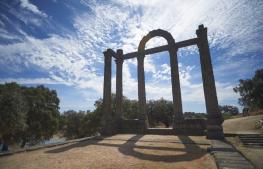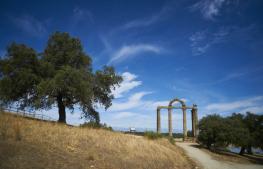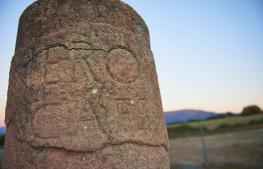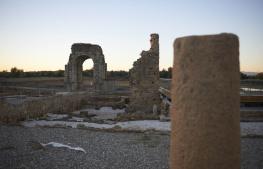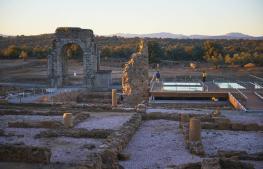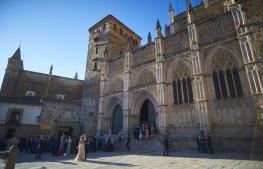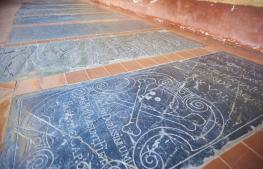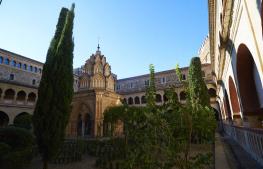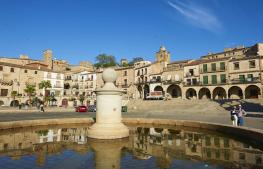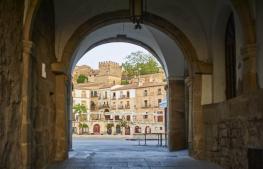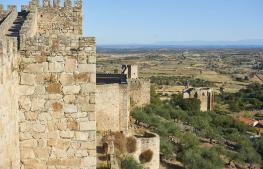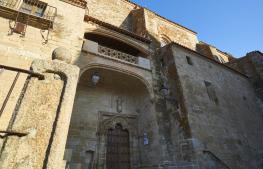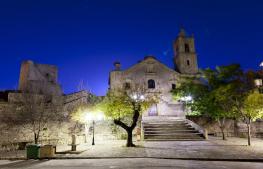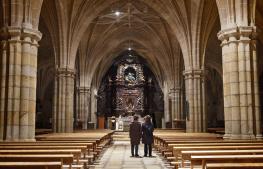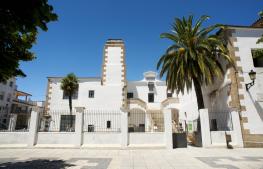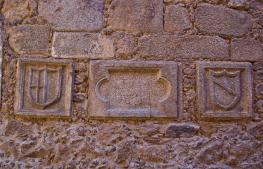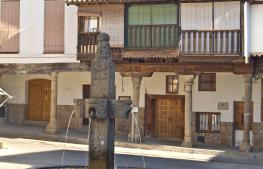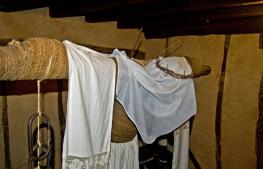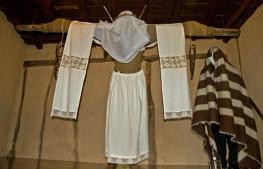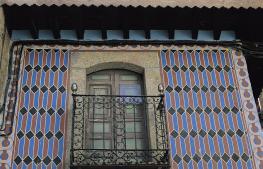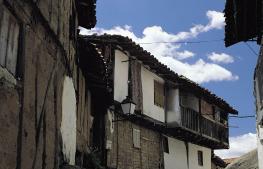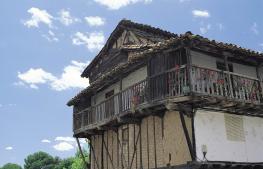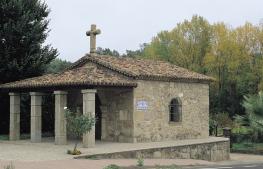Arts and crafts
"Passion for tradition"
Arts and crafts
Passion for tradition
Cáceres is history, culture, art, nature... and its people. The inhabitants have given every inch of this land its character, and they have been the focus of the passing of the centuries, as they manage to hold on to their customs and traditions: traditions represented in their buildings, courtyards, cuisine and also their arts and crafts.
Brozas Historical Site
"On the banks of the Tagus River"
Brozas Historical Site
On the banks of the Tagus River
The town of
Its geographical situation, the extent of its municipal area and its proximity to the Portuguese border all made it a point of reference within the province. Brozas Castle, in the upper part of the town, is part of the memory of its past, another highlight of which is having been the seat of the Grand Commandry of the Order of Alcántara.
Cabezuela del Valle Historical Site
"The heart of the Jerte Valley"
Cabezuela del Valle Historical Site
The heart of the Jerte Valley
The municipality of Cabezuela del Valle is found in the central part of the Jerte Valley.
With a triangular layout, its historic centre breaks away from the linear structure of other towns. Originally founded on a hill in medieval times, the town grew down the sides until stopping at the banks of the River Jerte, whose course through the town includes the natural pools La Picaza and La Pesquerona.
Coria Cathedral
"Gothic-Plateresque"
Coria Cathedral
Gothic-Plateresque
Coria is the most important city in the north-eastern area of Cáceres, known for its rich historical and heritage value, including its cathedral.
This grand structure rises up out of the southern stretch of the Roman wall. Coria’s Cathedral de la Asunción was built between the 16th and 18th centuries to replace an older church of which only the 14th-century cloister remains.
Coria Historical Site
"Model of town planning"
Coria Historical Site
Model of town planning
The historic centre of Coria has been considered an Asset of Cultural Interest in the Historical Site category since 25 May 1993. The city of Coria is one of the most outstanding models of town planning in Extremadura.
This historical site is the legacy of the different cultures that inhabited this place of Roman origin, as evidenced by its walls, which form a polygonal enclosure made of ashlar, while it was also an episcopal see during the Visigothic period and estate of the Dukes of Alba in the 15th century.
Cuacos de Yuste Historical Site
"Aesthetic Reserve"
Cuacos de Yuste Historical Site
Aesthetic Reserve
Back in 1959, the town of Cuacos de Yuste, in the county of La Vera, was declared an ‘Aesthetic Reserve’. The current equivalent of this designation would be an Asset of Cultural Interest in the Historical Site category.
One of the defining features of La Vera is its traditional architecture: determined by the physical elements of the area, it features a highland style that makes use of timber framing.
The winding routes of its streets and perfect condition of its traditional and stately architecture allow visitors to enjoy the charm of this lovely municipality.
Dolmens
"Funerary monuments"
Dolmens
Funerary monuments
The municipality of Valencia de Alcántara, in the county of Sierra de San Pedro, in the south-east of the province of Cáceres, is home to one of the Iberian Peninsula’s biggest collections of dolmens. This group of megalithic funerary monuments consists of 41 dolmens, 33 in granite and eight in slate.
El Palancar Monastery
"The world’s smallest convent"
El Palancar Monastery
The world’s smallest convent
El Palancar Monastery is located in the town of Pedroso de Acim, very close to the Sierra de Cañaveral mountains and the Jerte and Alagón Valleys.
It was founded by Brother Pedro de Alcántara in 1557. Being familiar with his story makes it easier to understand this monument. Humble in nature, Brother Pedro de Alcántara studied at the University of Salamanca, where he came into contact with Saint Francis of Assisi. His closeness to the people and humility turned him into a much-loved figure among those who knew him.
Festivals of Tourist Interest
"Centuries of folklore and popular culture"
Festivals of Tourist Interest
Centuries of folklore and popular culture
The province of Cáceres is home to one Festival of International Tourist Interest and two festivals declared as being of National Tourist Interest. The first, and most prominent, festival is Holy Week in Cáceres, followed by the Cherry Blossom Festival and Jarramplas. Cáceres’ Holy Week celebrations are a treat for the senses.
Its origins go back to the 15th century, and every year more and more people get involved, as is evident from the unstoppable growth in the number of members that make up each of the 16 associations that are the stars of the festivities.
Galisteo Historical Site
"Mozarabic past"
Galisteo Historical Site
Mozarabic past
Galisteo is a town located 90 kilometres from Cáceres, by the River Jerte.
Its origins date back to the Roman and Moorish periods, although its golden age was between 1229 and 1837, when it was the village capital of the Galisteo Estate, whose territory included villages such as Pozuelo de Zarzón, Guijo de Galistero, Montehermoso and Carcaboso.
Remnants of its important past that still stand today include its wall, which still completely surrounds the old part of the town, next to which is the keep known as ‘La Picota’, considered the town’s greatest symbol.
Garganta la Olla Historical Site
"Architectural and natural heritage"
Garganta la Olla Historical Site
Architectural and natural heritage
The municipality of Garganta la Olla is in the county of La Vera.
Located very close to the Sierra de Tormantos mountains, a spur of the Sierra de Gredos mountains, it stands out for the ravines that give it its name.
In 1978 it was agreed for Garganta la Olla to be declared a Historical-Artistic Site due to the good conservation status of its traditional half-timber architecture and its stately homes.
Gata Historical Site
"At the foot of the mountains"
Gata Historical Site
At the foot of the mountains
The town of Gata is found in the mountain range of the same name. It location has determined the evolution of its history, and this is reflected in its layout and town planning, typical of highland towns.
The traditional architecture in Gata is characterised by tall houses with two or three storeys. On the ground floor you can find cellars and stables, with rooms and bedrooms on the second and the kitchen (with no fireplace), pantry and the attic.
Grandilla Historical Site
"Museum town"
Grandilla Historical Site
Museum town
Granadilla was founded by the Moors in the 9th century. Since then, the different cultures that have lived within its walls have changed the course of its history on several occasions.
But if there’s one moment in recent history that changed it for good, it would be the construction of the Gabriel y Galán reservoir in 1965.
This forced the population to relocate due to the risk of flooding and the gradual deterioration of the town. Although the town was not submerged, it did become surrounded by water, leaving it on a peninsula protected by the wall.
Guadalupe Historical Site
"Much more than a monastery"
Guadalupe Historical Site
Much more than a monastery
Guadalupe is known for its famous monastery, but the town is home to other architectural, town-planning and cultural landmarks that resulted in it being declared a Historical-Artistic Site in 1943.
The Royal Monastery of Guadalupe was built in the 14th century. It soon became one of the most outstanding religious and cultural centres in the Iberian Peninsula.
Hervás Historical Site
"Sephardic past"
Hervás Historical Site
Sephardic past
Hervás is a town set in a privileged environment in the Ambroz Valley.
Its origins go back to the 12th century. As with other towns in the province, the fact that the Silver Route runs through the municipal boundaries means it has always been in contact with other peoples and cultures.
The Knights Templar erected a castle in Hervás during the Reconquest. Hervás belonged to Béjar, and both depended on the estate of the Zúñiga family, the Dukes of Béjar, until King Ferdinand VII declared Hervás a free town in 1816.
Monastery of Yuste European Heritage
"Royal residence"
Monastery of Yuste European Heritage
Royal residence
On one side of the Sierra de Tormantos mountains, two kilometres from the town of Cuacos, stands the Monastery of Saint Jerome of Yuste, an imposing structure where the Holy Roman Emperor Charles V (King Charles I of Spain) spent the last two years of his life.
Its origins go back to the 13th century, when the owner of the lands the monastery occupies transferred them to a religious community, the ‘Ermitaños de la Pobre Vida’, so they could build a convent.
Monumental city of Cáceres
"World Heritage"
Monumental city of Cáceres
World Heritage
The topography plays an important role in the urban development of Cáceres, as the city stands on uneven ground, between the Sierra de la Mosca mountains and La Sierrilla, on ground with hardened quartzites and an abundance of granite. This land provides plentiful building materials, which the Romans used to erect a 68,000-square-metre wall and which the local nobility used centuries later to build their mansions, mainly using granite, slate and quartzite.
Old Town of Cáceres
"Monumental site"
Old Town of Cáceres
Monumental site
The decree declaring Cáceres as a Monumental Site was published on 21 January 1949, and in 1986 UNESCO included the Old Town of Cáceres in its list of World Heritage Sites.
The city of Cáceres is a reflection of all the cultures that have lived within its walls, and in later years, the city even saw growth beyond its walls.
Pasarón de La Vera Historical Site
"Cradle of civilisations"
Pasarón de La Vera Historical Site
Cradle of civilisations
Pasarón de La Vera is a town located on the western edge of the county of La Vera.
The Historical Site comprises the properties within the perimeter outlined by certain streets as well as those facing either side of those streets.
Pasarón de La Vera is organised around three squares where you can find the most important buildings in the town: the town hall, church and Palace of the Counts of Osorio. It is worth strolling through its streets and discovering its architecture and charm.
Plasencia Cathedral
"The Old Cathedral and the New Cathedral"
Plasencia Cathedral
The Old Cathedral and the New Cathedral
The building we see today is the result of the juxtaposition of two cathedrals, the old one and the new one.
Construction on the Old Cathedral began with the Western Door in the 13th century, following the three-nave Castilian Romanesque church model. Of particular interest is the Chapter Hall or Chapel of San Pablo, which has a square design covered with an umbrella dome.
Plasencia Historical Site
"Monumental city"
Plasencia Historical Site
Monumental city
Plasencia is a city located in the north of the province of Cáceres. It benefits from a strategic location, the entryway to the counties of Ambroz, Jerte and La Vera, the commercial hub for an extensive area of northern Cáceres.
The River Jerte runs through the city, which was reconquered by Alfonso VIII at the end of the 12th century.
The layout of the area of the city inside the walls is organised around the rectangular, porticoed Plaza Mayor square. The main streets radiate from this point to the gates in the wall.
Robledillo de Gata Historical Site
"Architectural harmony"
Robledillo de Gata Historical Site
Architectural harmony
Robledillo de Gata is a municipality in the county of Sierra de Gata. Its historic centre forms one of the best examples of traditional and domestic architecture preserved in the province of Cáceres.
Walking its streets takes you back to ancient ways of life. The houses are full of charm. Some walls are made from adobe, while others are very small stonework, with slate stones in the corners. Both forms are alternated with timber framing.
Roman bridge of Alcántara
"The bridge that will remain standing for centuries"
Roman bridge of Alcántara
The bridge that will remain standing for centuries
The Roman bridge in Alcántara was built between the years AD 104 and 106, and in 1924 was declared an Asset of Cultural Interest in the Monument category.
It stands out in particular for its grandness and strength that it still maintains today, nearly intact despite being almost 2,000 years old. Standing at 58.2 metres tall and 194 metres long, it is a beautiful construction, somewhere between art and engineering.
Roman ruins of Augustóbriga
"‘Los Mármoles’"
Roman ruins of Augustóbriga
‘Los Mármoles’
Bohonal, in the north-east of the province of Cáceres, is home to the ruins of the ancient Roman city of Augustóbriga, buried below the town of Talavera la Vieja.
The area was flooded by water when the Valdecañas reservoir was built in 1960.
The city of Augustóbriga was established in the hollow the reservoir covers today, and corresponded to the Extremaduran town of Talavera la Vieja (also known as Talaverilla by locals), growing to 2,000 inhabitants before it disappeared.
Roman ruins of Cáparra
"Imperial city"
Roman ruins of Cáparra
Imperial city
One highlight of the province of Cáceres is the numerous traces of its Roman-age splendour. One set of ruins prominent among them are those of Cáparra, in the county of Tierras de Granadilla, in the north of the province, between the municipalities of Oliva de Plasencia and Guijo de Granadilla.
Royal Monastery of Guadalupe World Heritage
"700 years of history"
Royal Monastery of Guadalupe World Heritage
700 years of history
Legend has it that in the early 14th century, in the valleys of Las Villuercas, the cowherd Gil Cordero was looking for a lost cow from his herd, which he found dead. When he went to quarter the animal, it came back to life. At that moment, the Virgin Mary appeared to him and told him to spread the word of the miracle and dig in the same place where he had found his dead cow. There, he found a statue of the Blessed Virgin, and its reputation as being miraculous spread quickly.
Test of content
"My subtitle"
Trujillo Historical Site
"Adventure and heritage"
Trujillo Historical Site
Adventure and heritage
Trujillo, a municipality in the county of Miajadas-Trujillo, is the heir to one of Extremadura’s finest examples of architectural heritage.
The town is the result of the different cultures that have inhabited it. From Roman Turgalium to the period of Moorish rule, when it acquired prominent significance, with the construction of a fortress in the time of the caliphate and an important part of the wall, confirming the strategic interest of ‘Turyla’.
Valencia de Alcántara Historical Site
"Gothic Quarter"
Valencia de Alcántara Historical Site
Gothic Quarter
Valencia de Alcántara is a town in the county of Sierra de San Pedro. It is in the west of the province of Cáceres, on the border with Portugal.
The city was retaken from the Moors in 1221 by the Knights of Saint Julian de Pereiro, an old military order that evolved into the powerful Order of Alcántara. The conquest resulted in the town becoming directly dependent on the king as a ‘Villa de Realengo’.
Valverde de La Vera Historical Site
"A stately village"
Valverde de La Vera Historical Site
A stately village
Valverde de La Vera is a village located in the county of La Vera.
It is organised in the shape of a cross, based around a main road with four main crossroads: the Plaza de España square, Fuente de los Cuatro Caños fountain, the church and the Plaza del Rollo square.
Spouts or ditches run along all its streets to channel rainwater. In Plaza de España there is an arcade with granite columns, decorated with balls and mouldings.
Villanueva de La Vera Historical Site
"Unique traditional architecture"
Villanueva de La Vera Historical Site
Unique traditional architecture
This is one of the most easterly towns in the county of La Vera, and was declared a Historical Site in 1982.
It has unmistakable Roman traits. There are remains of a pre-Roman settlement on Castrejón Hill, as well as a dolmen on the outskirts of the town, providing evidence that the area has been home to humans since ancient times.

